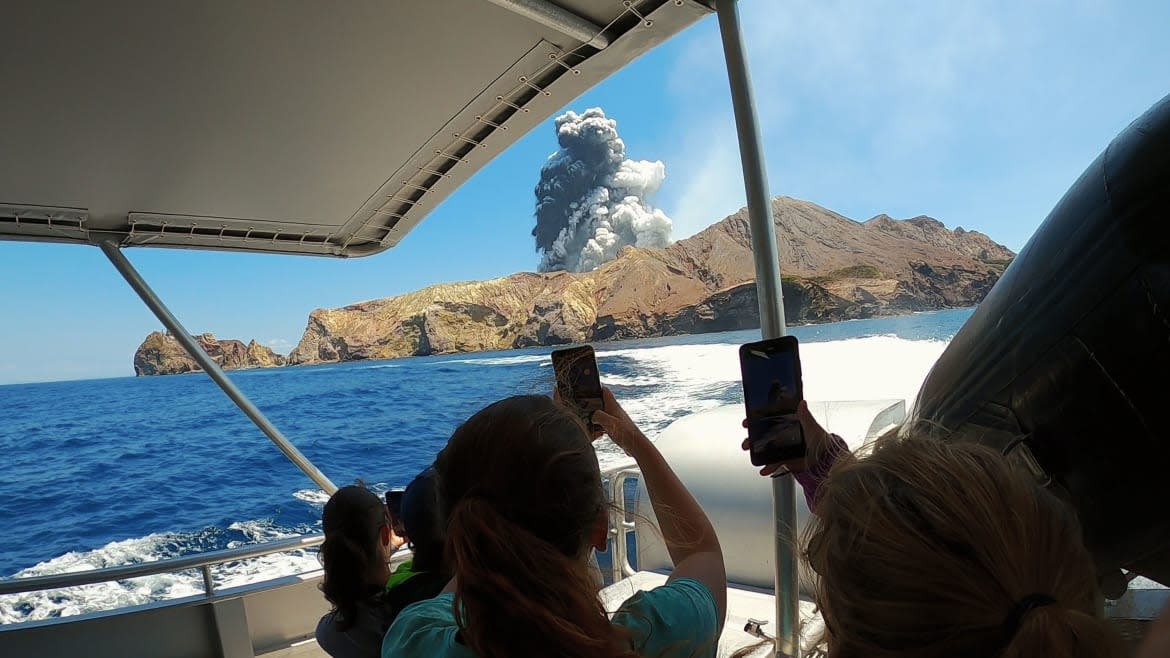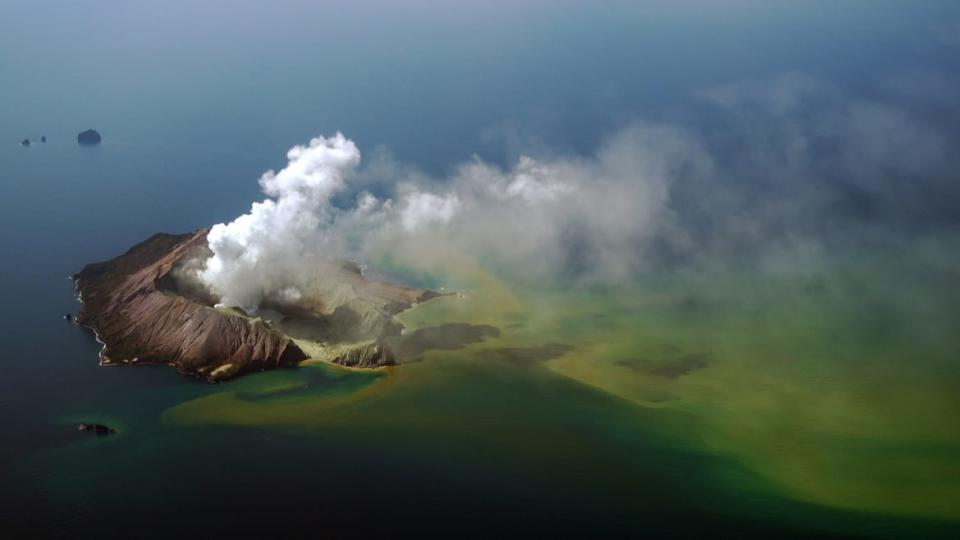‘The Volcano: Rescue from Whakaari’ Shows Nature at Its Cruelest

- Oops!Something went wrong.Please try again later.
People show their true colors in crises, and in that regard The Volcano: Rescue from Whakaari is a touching tale of individuals risking their own safety in order to help loved ones and strangers alike. Such altruism is the engine that drives Downfall: The Case Against Boeing director Rory Kennedy’s Netflix documentary (Dec. 16), which revisits the Dec. 9, 2019, eruption of a stratovolcano on Whakaari—also known as White Island, located on the east coast of New Zealand’s North Island—in minute-by-minute detail. It’s as pulse-pounding and harrowing as any recent non-fiction effort.
Whakaari was, at least until its most recent eruption, a popular tourist attraction, and The Volcano: Rescue from Whakaari focuses on the experiences of four people who chose to visit it on that fateful day. Pastor Geoff Hopkins was there with his daughter, who was studying geology and volcanic activity and thought it would be a fun surprise to treat her dad to a Whakaari tour for his 50th birthday. Jesse Langford was an Australian traveling with his family on a New Zealand cruise who admits that he and his sister sought out “enjoyable risk,” be it going black water rafting or bungee jumping off Auckland Tower. Matt and Lauren Urey, meanwhile, were honeymooning Americans, with Matt the bigger “adventure-seeker” and Lauren his more beach-oriented partner.
This foursome, as well as dozens of others, set out for Whakaari on the morning of Dec. 9, excited and/or nervous about the opportunity to walk along an active volcano that, as plentiful clips elucidate, regularly spewed steam and whose rocky, ashy, muddy ground was covered in sulfur deposits that made everything bright yellow and sparkle in the sunlight. It was a rare chance to flirt with Mother Nature at her most volatile, and initially, the sightseers got exactly what they paid for as they traipsed up from the coastline to the crater, which—according to guide Hayden Marshall-Inman—was at a level 2 risk, meaning it was somewhere between dormant and erupting. That assessment turned out to be inaccurate, as on their way back down to the boat shortly after 2 p.m., Matt heard someone yell, “Hey, look at that!” When he turned around, he saw a plume of chimney smoke silently blasting out of the crater.
In mere moments, panic set in, and with good reason. Whakaari immediately became as perilous a location as any on Earth, emitting scalding smoke and ash that covered the island and—at a temperature of approximately 200 degrees Celsius—burned anyone who came into contact with it. Matt and Lauren took cover behind a rock outcropping, getting pelted by falling debris as their skin began to boil. Jesse, who was at the crater when it blew, remembers only seeing his father and mother one last time before everything went dark. And Geoff, who by this point was on a boat headed back to the mainland, watched the catastrophe bloom before his eyes—a sight that The Volcano: Rescue from Whakaari presents via cell phone footage shot by Geoff’s fellow passengers. Between that and brief video and audio clips taken by fleeing tourists, as well as surveillance photographs and testimonials, Kennedy’s film does a striking job situating viewers in the thick of the ordeal.

After building ominous momentum during its first half hour, The Volcano: Rescue from Whakaari becomes a portrait of chaos, despair, and, finally, heroism. Within minutes, much of the mainland knew that something unusual and terrible had taken place on Whakaari, and a few brave souls—led by commercial helicopter pilots Mark Law and Tim Barrow—leapt into action, knowing that they could reach the volcano in under 30 minutes, which was far quicker than the 1.5-hour boat journey that the Coast Guard had to undertake. Along with private pilot John Funnell, who happened to be in the air that day, they ventured to the still-erupting volcano, working in tandem to survey the damage, spot possible survivors, and, in the case of Law and Barrow, to land and then pile every last breathing person into their ill-equipped crafts.
“This is the stuff that nightmares are made out of,” says Funnell, and yet the natural disaster also turned out to be a proving ground for selfless courage and sacrifice. While Matt and Lauren managed to get aboard Geoff’s boat, where they were tended to as best as possible, Law and Barrow evacuated 12 injured men and women via three helicopters, leaving behind eight deceased. Everyone who made it out alive, however, was in bad shape; stories about skin peeling off live bodies and of victims’ shrieks and suffering make clear the severity of the situation. That horror, however, also underscores the bravery of those who struggled to save as many as they could, including commercial helicopter pilot Brian Depauw, who after taking refuge underwater during the eruption, returned to land to lend a helping hand.
Why ‘Avatar: The Way of Water’ Isn’t Worth the 13-Year Wait
Be it Matt and Lauren clinging to each other throughout this tragedy, Jesse finding the wherewithal to walk back down to shore (at which point he vainly tried to get first responders to find his family), or Geoff breaking down in tears upon reaching the mainland, The Volcano: Rescue from Whakaari is an account of perseverance and pain. The latter is perhaps felt the hardest by the likes of Ngaroahiahi Patuwai Maangi and Mark Inman, whose grandson and brother, respectively, were guides who perished on Whakaari. Kennedy’s documentary so fixates on the exacting details of that morning—step by step, second by second, scream by scream—that it inspires intense engagement with its subjects’ plights, as well as sorrow over the lives lost, which eventually totaled 22 (due to many passing away as a result of their injuries). There’s no exhilaration here, only terror and anguish and, in the case of Matt and Lauren, scars that haven’t fully healed and anger (over a sense that they were misled about the dangers of visiting Whakaari) that hasn’t subsided.
In its stories of strength and resolve, heartache and fury, The Volcano: Rescue from Whakaari is a disaster film in the truest sense of the term—one that makes Hollywood’s own blockbuster calamities look cheap and exploitative by comparison.
Get the Daily Beast's biggest scoops and scandals delivered right to your inbox. Sign up now.
Stay informed and gain unlimited access to the Daily Beast's unmatched reporting. Subscribe now.

